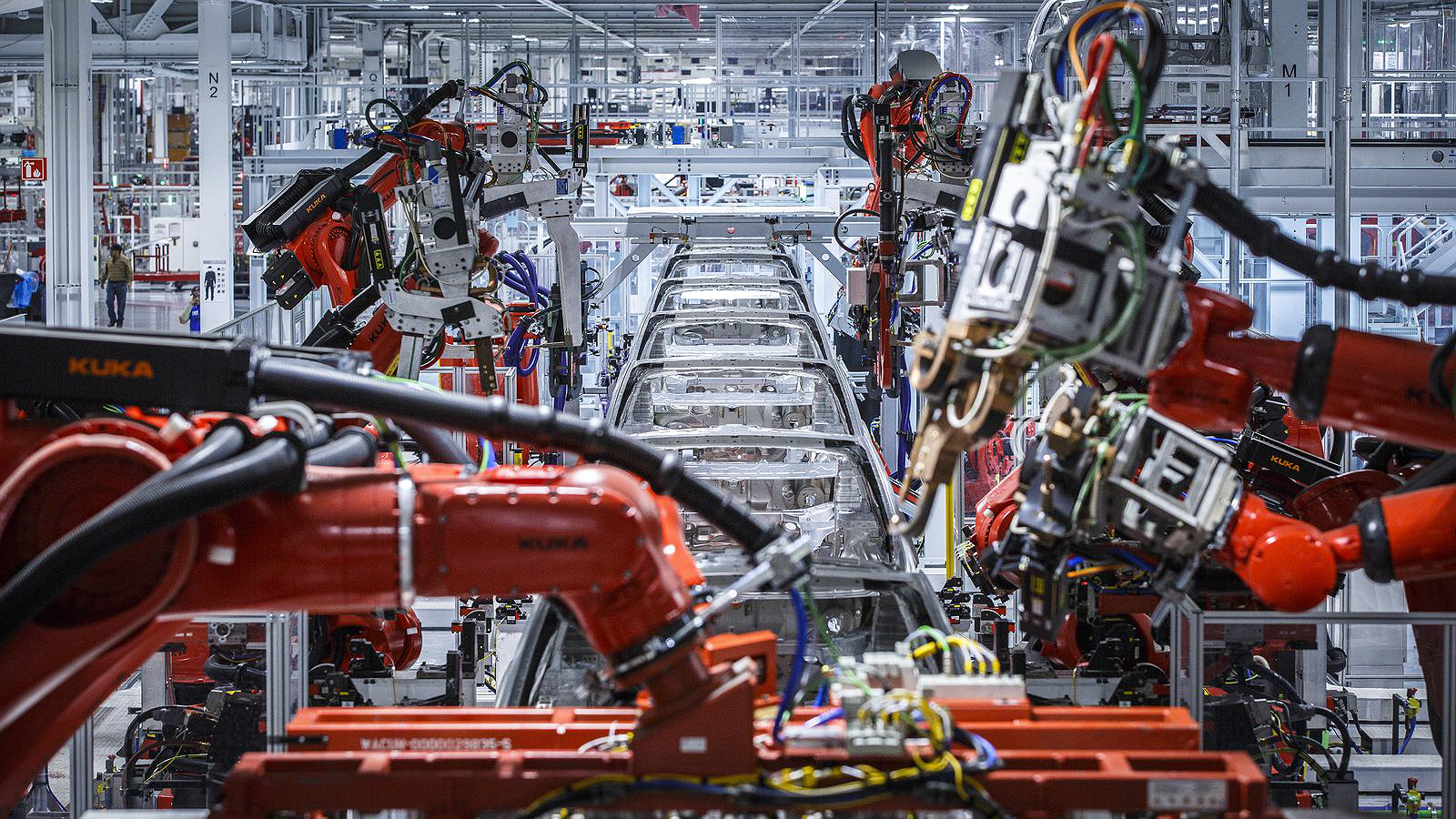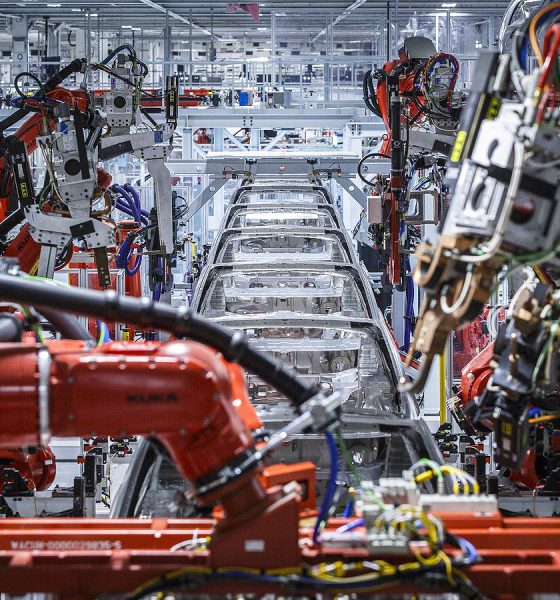

Investor's Corner
Tesla reportedly flies in 6 planes’ worth of robots in latest Model 3 push
As part of its ongoing Model 3 push, Tesla has reportedly flown in six airplanes’ worth of new robots from Europe to California. According to sources familiar with the matter, the deliveries of the new equipment comes amidst Tesla CEO Elon Musk’s initiatives to hit the company’s self-imposed goal of producing 5,000 Model 3 per week by the end of June.
The sources, who spoke under anonymity to Reuters, stated that the deliveries of the robots were done “in a massive hurry.” One of the two individuals who spoke to the publication also noted that the first two shipments have arrived at Reno, Nevada. The robots will reportedly be installed in Gigafactory 1’s battery module production line.
Tesla, as of Friday, has so far declined to comment on the matter.
The practice of flying new equipment from one continent to another is rather unorthodox in the automotive industry. Transport by air, after all, is incredibly costly. Nevertheless, the deliveries of the new robots underscore the urgency that the electric car maker is feeling at the moment, considering its goals for the Model 3.
One of the sources also noted that engineers from Tesla’s German engineering arm, Grohmann, have been deployed to Gigafactory 1 in Nevada to address further production bottlenecks in the production of the compact electric car’s battery packs.
The Tesla Model 3 has been a particular pain point for the Elon Musk-led company. The vehicle has so far missed its production targets since the company began manufacturing it last year. During the Q1 2018 earnings call, however, Tesla CEO Elon Musk reiterated his stance about the company’s capability to hit a production rate of 5,000 Model 3 per week.
As noted in Tesla’s Q1 2018 Update Letter, the Model 3 line would be undergoing a series of production shutdowns that are designed to make way for improvements in the electric car’s manufacturing line. This was also outlined in a leaked email from Musk to his employees last April, which explained the upgrades that would be coming after the scheduled shutdowns.
According to Musk’s correspondence, the halt in April would enable the company to produce 3,000-4,000 Model 3 per week. Following this would be a shutdown late May, which would ultimately allow the company to achieve a rate of 5,000-6,000 Model 3 per week, thanks to what Musk described as a “comprehensive set of upgrades” to the production line.
Tesla has recently been showing encouraging signs about its Model 3 push. Just last week, the Elon Musk-led company registered 7,237 new Model 3 VINs, its largest single batch to date. Another leaked email from Musk also revealed that the company is producing 500 vehicles a day, or 3,500 Model 3 a week.
Just recently, the company also opened orders for the Model 3’s dual-motor AWD and Performance variants. The two new options of the Model 3, as stated by Musk in a previous tweet, will be offered by Tesla as soon as the company is able to manufacture 5,000 Model 3 per week consistently. Considering that Tesla just sent out the first batch of configuration invites for the dual-motor AWD and Performance Model 3, it appears that the company is starting to become a bit more confident in its ability to manufacture its most ambitious vehicle to date.

Investor's Corner
Tesla stock closes at all-time high on heels of Robotaxi progress

Tesla stock (NASDAQ: TSLA) closed at an all-time high on Tuesday, jumping over 3 percent during the day and finishing at $489.88.
The price beats the previous record close, which was $479.86.
Shares have had a crazy year, dipping more than 40 percent from the start of the year. The stock then started to recover once again around late April, when its price started to climb back up from the low $200 level.
This week, Tesla started to climb toward its highest levels ever, as it was revealed on Sunday that the company was testing driverless Robotaxis in Austin. The spike in value pushed the company’s valuation to $1.63 trillion.
Tesla Robotaxi goes driverless as Musk confirms Safety Monitor removal testing
It is the seventh-most valuable company on the market currently, trailing Nvidia, Apple, Alphabet (Google), Microsoft, Amazon, and Meta.
Shares closed up $14.57 today, up over 3 percent.
The stock has gone through a lot this year, as previously mentioned. Shares tumbled in Q1 due to CEO Elon Musk’s involvement with the Department of Government Efficiency (DOGE), which pulled his attention away from his companies and left a major overhang on their valuations.
However, things started to rebound halfway through the year, and as the government started to phase out the $7,500 tax credit, demand spiked as consumers tried to take advantage of it.
Q3 deliveries were the highest in company history, and Tesla responded to the loss of the tax credit with the launch of the Model 3 and Model Y Standard.
Additionally, analysts have announced high expectations this week for the company on Wall Street as Robotaxi continues to be the focus. With autonomy within Tesla’s sights, things are moving in the direction of Robotaxi being a major catalyst for growth on the Street in the coming year.
Elon Musk
Tesla needs to come through on this one Robotaxi metric, analyst says
“We think the key focus from here will be how fast Tesla can scale driverless operations (including if Tesla’s approach to software/hardware allows it to scale significantly faster than competitors, as the company has argued), and on profitability.”

Tesla needs to come through on this one Robotaxi metric, Mark Delaney of Goldman Sachs says.
Tesla is in the process of rolling out its Robotaxi platform to areas outside of Austin and the California Bay Area. It has plans to launch in five additional cities, including Houston, Dallas, Miami, Las Vegas, and Phoenix.
However, the company’s expansion is not what the focus needs to be, according to Delaney. It’s the speed of deployment.
The analyst said:
“We think the key focus from here will be how fast Tesla can scale driverless operations (including if Tesla’s approach to software/hardware allows it to scale significantly faster than competitors, as the company has argued), and on profitability.”
Profitability will come as the Robotaxi fleet expands. Making that money will be dependent on when Tesla can initiate rides in more areas, giving more customers access to the program.
There are some additional things that the company needs to make happen ahead of the major Robotaxi expansion, one of those things is launching driverless rides in Austin, the first city in which it launched the program.
This week, Tesla started testing driverless Robotaxi rides in Austin, as two different Model Y units were spotted with no occupants, a huge step in the company’s plans for the ride-sharing platform.
Tesla Robotaxi goes driverless as Musk confirms Safety Monitor removal testing
CEO Elon Musk has been hoping to remove Safety Monitors from Robotaxis in Austin for several months, first mentioning the plan to have them out by the end of 2025 in September. He confirmed on Sunday that Tesla had officially removed vehicle occupants and started testing truly unsupervised rides.
Although Safety Monitors in Austin have been sitting in the passenger’s seat, they have still had the ability to override things in case of an emergency. After all, the ultimate goal was safety and avoiding any accidents or injuries.
Goldman Sachs reiterated its ‘Neutral’ rating and its $400 price target. Delaney said, “Tesla is making progress with its autonomous technology,” and recent developments make it evident that this is true.
Investor's Corner
Tesla gets bold Robotaxi prediction from Wall Street firm
Last week, Andrew Percoco took over Tesla analysis for Morgan Stanley from Adam Jonas, who covered the stock for years. Percoco seems to be less optimistic and bullish on Tesla shares, while still being fair and balanced in his analysis.

Tesla (NASDAQ: TSLA) received a bold Robotaxi prediction from Morgan Stanley, which anticipates a dramatic increase in the size of the company’s autonomous ride-hailing suite in the coming years.
Last week, Andrew Percoco took over Tesla analysis for Morgan Stanley from Adam Jonas, who covered the stock for years. Percoco seems to be less optimistic and bullish on Tesla shares, while still being fair and balanced in his analysis.
Percoco dug into the Robotaxi fleet and its expansion in the coming years in his latest note, released on Tuesday. The firm expects Tesla to increase the Robotaxi fleet size to 1,000 vehicles in 2026. However, that’s small-scale compared to what they expect from Tesla in a decade.
Tesla expands Robotaxi app access once again, this time on a global scale
By 2035, Morgan Stanley believes there will be one million Robotaxis on the road across multiple cities, a major jump and a considerable fleet size. We assume this means the fleet of vehicles Tesla will operate internally, and not including passenger-owned vehicles that could be added through software updates.
He also listed three specific catalysts that investors should pay attention to, as these will represent the company being on track to achieve its Robotaxi dreams:
- Opening Robotaxi to the public without a Safety Monitor. Timing is unclear, but it appears that Tesla is getting closer by the day.
- Improvement in safety metrics without the Safety Monitor. Tesla’s ability to improve its safety metrics as it scales miles driven without the Safety Monitor is imperative as it looks to scale in new states and cities in 2026.
- Cybercab start of production, targeted for April 2026. Tesla’s Cybercab is a purpose-built vehicle (no steering wheel or pedals, only two seats) that is expected to be produced through its state-of-the-art unboxed manufacturing process, offering further cost reductions and thus accelerating adoption over time.
Robotaxi stands to be one of Tesla’s most significant revenue contributors, especially as the company plans to continue expanding its ride-hailing service across the world in the coming years.
Its current deployment strategy is controlled and conservative to avoid any drastic and potentially program-ruining incidents.
So far, the program, which is active in Austin and the California Bay Area, has been widely successful.








